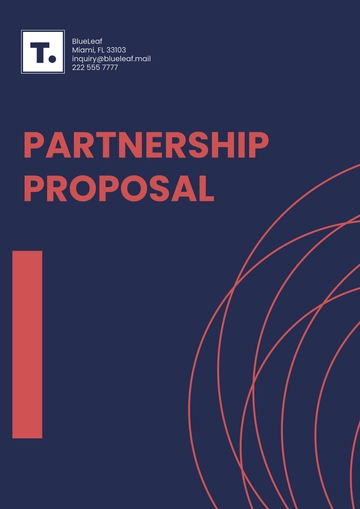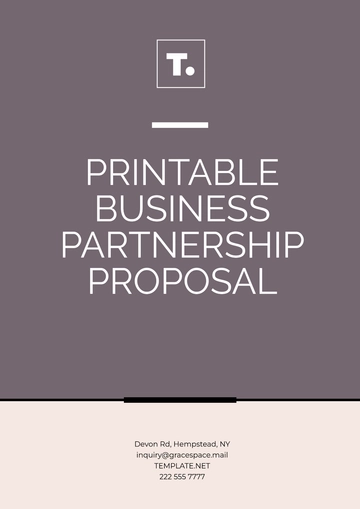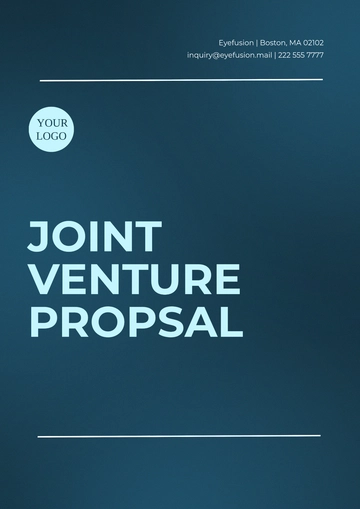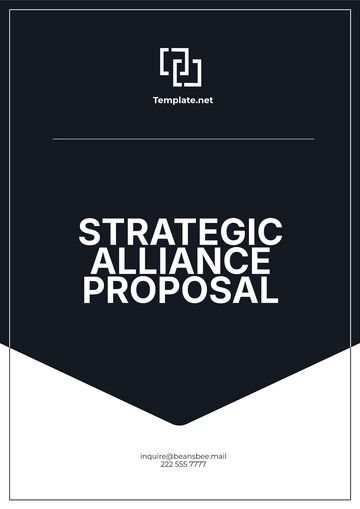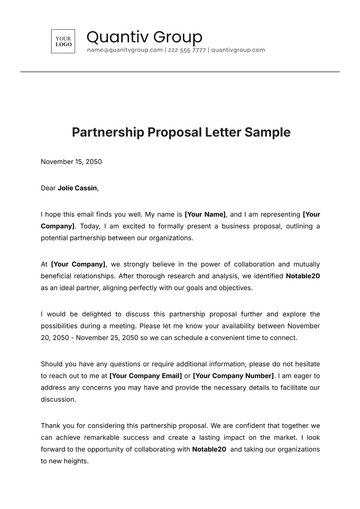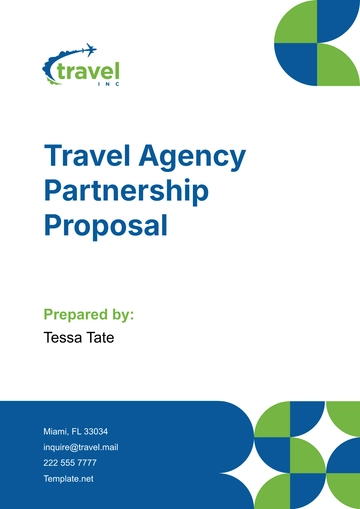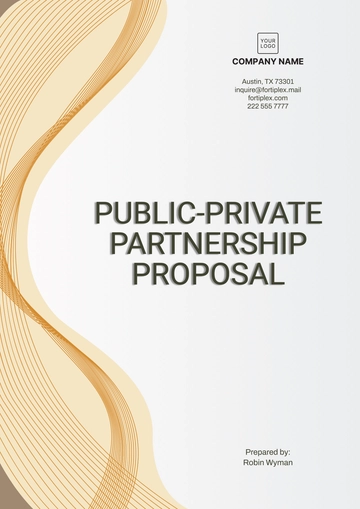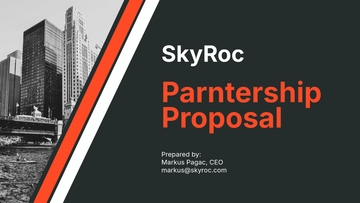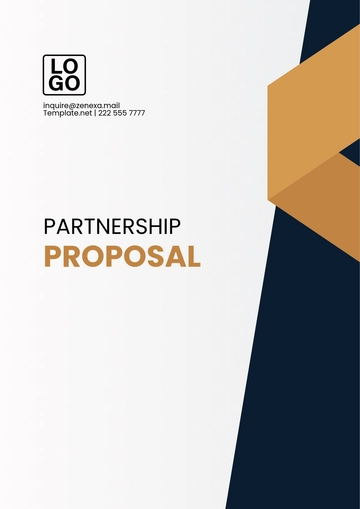Free Community Center Partnership Proposal
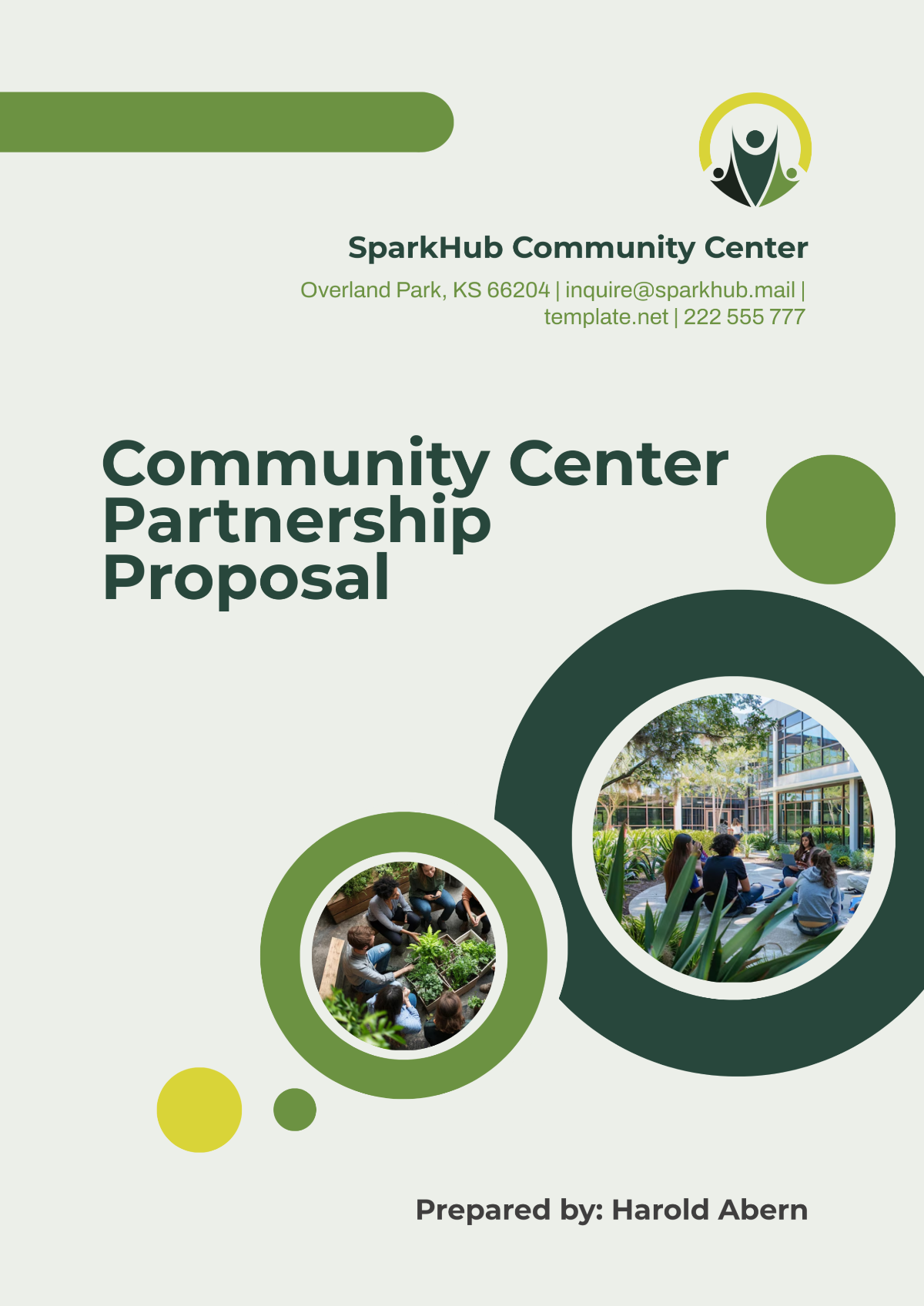
I. Introduction
A. Overview of Partnership Proposal
[Your Company Name], as the cornerstone of community services, is proposing a strategic partnership with key local stakeholders, including businesses, government agencies, and non-profit organizations. This proposal is designed to combine our collective resources, skills, and expertise to tackle the pressing challenges faced by our residents. By forming this partnership, we aim to create a comprehensive framework for delivering vital services in education, healthcare, economic empowerment, and social support, while reinforcing the importance of collaboration in building a sustainable future.
Our vision for this partnership is to transform the way services are delivered in our community, addressing gaps in existing offerings and ensuring that all residents—especially those in underrepresented and vulnerable groups—have access to the support they need to thrive. This partnership will not only enhance the quality of life for individuals but will also cultivate a stronger sense of community, resilience, and collective empowerment.
B. Objectives of the Partnership
The core objectives of this partnership are to:
Increase Service Accessibility: Expand access to critical programs, services, and resources for all community members, with a special focus on underserved populations. We believe that every individual, regardless of their socio-economic background, should have access to services that support their growth and well-being.
Enhance Program Diversity and Quality: Ensure that our programs address a wide range of needs and interests, enhancing their quality to meet the diverse requirements of the community. This includes offering services for children, adults, seniors, and people with disabilities, while also catering to a variety of interests and life stages.
Strengthen Community Engagement: Develop a collaborative framework that includes active participation from residents, local organizations, and community leaders, ensuring that the community feels heard and valued. It is essential that community members have a sense of ownership in the partnership and that their voices shape the programs we offer.
Establish Long-term Sustainability: Foster a sustainable model of community service that relies on diverse funding sources, efficient resource allocation, and collaborative partnerships to ensure ongoing impact. This includes seeking funding from various avenues, such as grants, sponsorships, and community fundraising, as well as leveraging our resources for maximum impact.
Create Measurable Outcomes: Define clear goals and success metrics to track the effectiveness of the partnership, ensuring that we can monitor progress and adjust as needed to meet evolving community needs. This will include tracking program participation, health outcomes, employment success, and other key indicators that reflect the success of our initiatives.
We envision that by the year 2055, the partnership will have fundamentally transformed the community by providing services that empower individuals, strengthen families, and build long-lasting resilience. This partnership will also serve as a model for other communities, showcasing the power of collaboration and shared vision in creating meaningful and lasting change.
II. Community Needs and Opportunities
A. Community Assessment and Insights
In 2050, [Your Company Name] conducted a comprehensive community needs assessment, utilizing surveys, focus groups, and interviews to gather feedback from residents about their most pressing needs and challenges. The results indicated several key areas where residents expressed a desire for more support, including:
Youth Education and Development: A survey showed that [65]% of families reported a need for more after-school programs, educational tutoring, and enrichment activities for children and teenagers. In particular, there was a demand for STEM-related programs that could spark interest in fields such as engineering, robotics, and environmental sciences.
Healthcare Access: [58]% of respondents cited challenges in accessing preventative healthcare services, including routine check-ups, immunizations, and mental health care. Many residents expressed that they faced long wait times for appointments, lack of transportation to medical facilities, or an inability to afford services.
Job Training and Economic Support: There is a significant demand for job readiness programs, vocational training, and financial literacy education, with [45]% of the community indicating that they would benefit from enhanced career development opportunities. There was also a strong desire for programs that help individuals transition into the workforce, such as resume workshops, interview coaching, and internship placements.
The community's demographic profile also reveals a growing need for services tailored to specific age groups and populations, including youth, senior citizens, and individuals with disabilities. With the community population projected to grow by [20]% by 2060, it is critical to address these needs proactively. Furthermore, there is a noticeable increase in multi-generational households, which requires the design of intergenerational programs that serve both older adults and children or grandchildren.
B. Opportunities for Growth and Impact
The findings from the community assessment not only highlight areas of need but also present significant opportunities for growth and impact. Some key opportunities include:
Youth Development and Education: There is an opportunity to introduce a series of after-school programs, including STEM workshops, arts classes, and college preparation courses. These programs would empower young people with the skills necessary to succeed academically and professionally. Additionally, we can offer mentorship programs that connect youth with professionals in various fields, offering them guidance and support as they explore career options.
Health and Wellness Services: By partnering with local healthcare providers and wellness organizations, we can introduce health clinics, mental health support groups, and fitness programs. This will ensure residents have access to preventative care, as well as services to address mental health challenges, which were highlighted as a major concern in the community assessment. Moreover, wellness initiatives such as cooking classes, fitness challenges, and mindfulness workshops could promote healthier lifestyles and well-being.
Job Readiness and Career Pathways: By collaborating with businesses and educational institutions, we can establish job training and apprenticeship programs that equip community members with the skills needed to secure well-paying, sustainable employment. Additionally, financial literacy workshops could help residents manage their personal finances more effectively. We also see a great opportunity in offering specialized job readiness programs for underserved groups, such as single parents, veterans, and individuals with disabilities.
Senior Services: There is a growing need for programs designed specifically for seniors, such as socialization activities, home health services, and transportation support. Partnering with local organizations could provide these much-needed services, while also ensuring that elderly residents remain active and engaged in the community.
The partnership will also explore avenues for expanding existing programs, such as youth mentorship initiatives, senior engagement activities, and health screenings, thereby broadening their reach and accessibility. We will also prioritize the development of programs that build leadership capacity within the community, offering residents the opportunity to take on active roles in the programs and services offered by the center.
III. Proposed Partnership Framework
A. Scope and Structure of the Partnership
The partnership will be structured as a joint venture, where both [Your Company Name] and the selected partner organization(s) share responsibilities, resources, and decision-making authority. The partnership will operate through a collaborative framework that ensures mutual accountability and active involvement from all stakeholders.
The key aspects of the partnership structure include:
Co-Management: A steering committee comprising members from both [Your Company Name] and the partner organizations will oversee the strategic direction and operational decisions. This committee will meet quarterly to assess progress, set new goals, and allocate resources as needed. Regular feedback loops will ensure that the program remains relevant and responsive to community needs.
Resource Sharing: The partnership will leverage the strengths of each organization involved, with [Your Company Name] providing its established facilities and community presence, while the partner organizations will contribute their expertise, funding, and specialized services. This resource-sharing model will allow for a more efficient use of resources and will ensure that programs are delivered in a sustainable manner.
Joint Funding Model: The partnership will pursue a diverse funding model, which includes government grants, corporate sponsorships, and community-based fundraising efforts. This ensures that the partnership remains financially sustainable and able to scale its efforts over time. Furthermore, the joint funding model will allow the partnership to target a broader range of financial sources, reducing the reliance on any one donor or funding body.
B. Roles and Responsibilities
Each partner organization will contribute in different ways, leveraging their specific expertise to achieve shared objectives. Below are the key roles and responsibilities:
Partner Organization | Key Responsibilities |
|---|---|
[Your Company Name] | Facility management, community engagement, program coordination, and outreach. |
Local Government | Policy support, grant funding, and access to public facilities and services. |
Non-Profit Organization | Program design, participant recruitment, and volunteer coordination. |
Local Businesses | Corporate sponsorships, job placements, and resources for career development programs. |
By clearly defining roles and responsibilities, the partnership will ensure that each stakeholder has a vested interest in the success of the programs, while also holding each other accountable for the execution of key deliverables.
IV. Programs and Services Overview
A. Core Programs
The following core programs will be implemented under the partnership, each designed to address specific community needs identified in the assessment:
After-School Enrichment Programs: These programs will offer academic tutoring, arts and crafts, sports, and STEM-related activities, providing children and teens with a safe, engaging environment to develop skills outside of school hours.
Health and Wellness Clinics: These clinics will provide regular health screenings, mental health support, and wellness activities, ensuring that all community members have access to preventative care.
Job Training and Career Development: Through a combination of workshops, internships, and mentorship programs, these services will help individuals build the skills they need to enter or re-enter the workforce.
B. Specialized Services
In addition to the core programs outlined above, the partnership will provide a variety of specialized services tailored to meet the diverse needs of the community. These services will target specific groups, such as seniors, individuals with disabilities, and low-income families, providing them with additional resources and support.
Senior Services:
Socialization and Community Engagement: Recognizing the value of social interactions for senior residents, the partnership will offer regular social events, including dance nights, craft workshops, and gardening clubs, designed to enhance the mental and emotional well-being of older adults.
Transportation Assistance: Many seniors face challenges with transportation, particularly for medical appointments or social activities. A community-based transportation program will be introduced to help seniors get to and from essential services, ensuring they can remain independent and active participants in the community.
Caregiver Support Services: Family members who care for elderly loved ones often experience emotional and physical stress. The partnership will offer caregiver support programs, including counseling, workshops on caregiving skills, and respite care services to give caregivers much-needed breaks.
Disability Services:
Accessible Education Programs: Specialized educational programs will be designed to accommodate individuals with disabilities, ensuring they can fully participate in job training, life skills classes, and enrichment activities. These programs will include adaptive technologies and specialized staff to support learners.
Employment Support: The partnership will work closely with local businesses to provide employment opportunities for individuals with disabilities. This will include job placement services, interview coaching, and workplace accommodations to ensure a successful transition into the workforce.
Assistive Technologies and Equipment: The community center will be equipped with state-of-the-art assistive technologies, such as mobility aids, speech-to-text devices, and hearing assistance tools, enabling individuals with disabilities to fully engage in all offered programs and services.
Family Support Services:
Parenting Classes: Recognizing the critical role parents play in the development of their children, the partnership will provide parenting education programs that cover topics such as child development, positive discipline techniques, and navigating the challenges of modern parenting.
Family Counseling: The community center will offer family counseling services to help resolve conflicts, strengthen relationships, and provide guidance on managing stress. These services will be available to families facing challenges such as financial difficulties, mental health issues, or domestic concerns.
Financial Literacy for Families: Financial education is critical to empowering families, and the partnership will offer workshops on budgeting, saving, managing debt, and preparing for emergencies. These sessions will provide families with the knowledge and tools they need to manage their finances effectively and improve their overall financial stability.
C. Community Impact Goals
The partnership’s ultimate goal is to create measurable, lasting impact on the community. We aim to achieve the following community-wide outcomes:
Increase in Educational Attainment: By providing access to after-school programs, tutoring, and specialized learning opportunities, we aim to increase high school graduation rates and college enrollment among local youth by [10]% over the next five years.
Improved Health and Well-being: Through the introduction of health and wellness programs, regular screenings, and mental health support services, we aim to reduce preventable diseases and improve the overall mental health of the community. Our target is to increase preventative healthcare visits by [15]% by 2055.
Enhanced Employment Outcomes: The job training, mentorship, and career development services offered will help local residents secure meaningful employment. We aim to see a [20]% increase in local employment rates, particularly for underemployed and unemployed individuals.
Stronger Community Cohesion: By providing spaces for social interaction, supporting community-driven initiatives, and promoting civic engagement, we aim to strengthen the bonds within our community. We hope to see an increase in volunteerism and civic participation by [25]% by 2055.
These goals are ambitious but achievable with the support and commitment of all partnership stakeholders. By tracking our progress and continually adjusting our approach, we will be able to demonstrate the tangible impact of this partnership on the community.
V. Implementation Plan
A. Timeline and Phases
The partnership will be implemented in three key phases, with a detailed timeline for each stage. The initial phase will focus on foundational work, such as securing resources and establishing a strong community presence, while subsequent phases will involve scaling up programs and expanding services.
Phase | Timeline | Key Milestones |
|---|---|---|
Phase 1 | Q1 [2050] – Q4 [2050] | Partnership agreements signed, recruitment of key staff, design and preparation of programs. |
Each phase will be evaluated at its conclusion to ensure that goals are met and that any issues are addressed before moving forward. Feedback from the community, as well as data collected from program participants, will play a crucial role in shaping the direction of future phases.
B. Resource Allocation
Successful implementation of the partnership will require significant investment in both human and financial resources. Below are key resource areas and their estimated allocations:
Personnel:
The partnership will require a dedicated team of staff members, including program coordinators, instructors, social workers, health professionals, and administrative personnel. Based on the scale of the partnership, we estimate the need for [50] full-time and part-time employees.Facilities and Infrastructure:
[Your Company Name] will provide access to its existing community center facilities, which include meeting rooms, classrooms, fitness spaces, and outdoor recreational areas. Additional infrastructure improvements will be required to accommodate specialized services, such as ADA-compliant facilities and health clinic spaces.Technology and Equipment:
To ensure that programs run efficiently and effectively, investments will be made in technology. This includes computers, software for program management, and assistive devices for individuals with disabilities.Marketing and Outreach:
A robust marketing plan will be developed to raise awareness of the partnership and its programs. This will include digital marketing campaigns, community flyers, and local radio advertisements. An estimated [5]% of the annual budget will be allocated to outreach and community engagement efforts.
C. Risk Management and Mitigation
In any large-scale partnership, certain risks must be identified and mitigated to ensure success. Below are key potential risks and our strategies for addressing them:
Funding Shortfalls:
The sustainability of the partnership will depend on continued funding from a variety of sources. To mitigate the risk of funding shortfalls, the partnership will pursue diverse revenue streams, including government grants, corporate sponsorships, and local community donations.Program Participation Fluctuations:
Another potential challenge is fluctuating enrollment numbers. This can be mitigated by conducting targeted outreach efforts and adjusting program offerings based on community feedback and demand. Additionally, early registration incentives and partnership with schools can help ensure higher participation rates.Staffing Challenges:
The success of the partnership will rely heavily on the recruitment and retention of qualified staff. We plan to address this risk by offering competitive salaries, professional development opportunities, and fostering a positive work culture that promotes staff retention and satisfaction.Community Engagement:
If community members do not feel engaged or invested in the programs, they may not participate. To mitigate this, the partnership will employ continuous community engagement strategies, including regular town hall meetings, feedback surveys, and ongoing communication with local leaders.
VI. Financial Overview and Funding
A. Budget Breakdown
The total projected budget for the first year of the partnership is estimated at [450,000] dollars. This amount will cover personnel, program costs, marketing, and facility maintenance. The table below outlines a preliminary budget allocation:
Category | Amount ($) |
|---|---|
Personnel | 200,000 |
Total Estimated Budget | 200,000 |
B. Funding Sources and Sustainability
To fund this initiative, [Your Company Name] will seek financial contributions from a variety of sources, ensuring sustainability and reducing reliance on any single funding body:
Grants:
Local and federal government grants, as well as private foundation funding, will be pursued to support the core programs. We will identify and apply for grants that align with our mission to serve the community’s needs.Corporate Sponsorships:
We will approach local businesses and corporations for long-term sponsorships. This may include financial donations, in-kind contributions, or employee volunteer programs. In exchange, sponsors will receive recognition in community materials and at events.Community Fundraising:
Engaging the community in fundraising events is another important strategy. We will organize charity auctions, benefit dinners, and local crowdfunding campaigns to raise funds while also fostering a sense of community involvement.
By diversifying funding sources, we can ensure the long-term financial sustainability of the partnership and its programs, reducing the risk of funding instability and ensuring consistent service delivery.
VII. Marketing and Community Engagement
A. Branding and Visibility Strategy
A cohesive branding strategy will be developed to establish a strong identity for the partnership and ensure that community members are aware of its offerings. This will include:
Logo and Slogan: A partnership logo and slogan that represent the community’s diversity, unity, and growth will be developed and featured on all promotional materials.
Website and Social Media Presence: A dedicated website will be launched, offering easy access to program information, registration, and contact details. Social media platforms will be used to engage with a broader audience, share success stories, and promote upcoming events.
B. Community Engagement Campaigns
Outreach efforts will include:
Community Meetings: Regularly scheduled meetings with local residents to share information, gather feedback, and keep the community informed about progress.
Surveys and Feedback: Continuous feedback will be collected from program participants to ensure that their needs are being met and that programs are evolving based on community input.
Partnership with Local Media: Collaboration with local newspapers, radio stations, and TV channels will help to increase visibility and engagement with a wider audience.
By actively involving the community in the partnership’s development and operation, we will build trust, generate excitement, and increase participation in the programs.
VIII. Evaluation and Impact Assessment
A. Monitoring and Evaluation Framework
To ensure that the partnership is achieving its objectives and making a measurable impact, a robust monitoring and evaluation (M&E) framework will be established. This framework will help track the progress of the programs and services and will provide valuable insights for improving future initiatives.
Key Performance Indicators (KPIs)
KPIs will be defined for each core program, specialized service, and overall community impact goal. These metrics will be tracked regularly to assess whether the program is meeting its targets and to identify areas for improvement. Some of the key performance indicators include:Program Participation Rates: Measuring the number of individuals participating in each program, broken down by age, gender, and other demographics.
Satisfaction Levels: Surveys will be conducted with program participants to measure their satisfaction with the services provided. This will help identify any gaps or areas where improvements can be made.
Health Outcomes: For health and wellness programs, health metrics such as reduced instances of chronic illness or increased participation in screenings will be tracked.
Employment Outcomes: Tracking the number of individuals who secure employment or complete job training programs will help evaluate the success of career development initiatives.
Volunteer and Community Engagement: The level of community involvement, including the number of volunteers and community-driven projects, will also be tracked to measure the program's impact on social cohesion.
Data Collection and Analysis
Data will be collected through a variety of methods, including surveys, participant interviews, focus groups, and program reports. This data will be analyzed quarterly to ensure that all programs are operating effectively and efficiently. Regular analysis will enable the team to make data-driven decisions and adjust programming as needed.Annual Impact Reports
Each year, an annual impact report will be produced, summarizing the results of the previous year’s programs and services. This report will provide an in-depth look at the progress toward meeting the community goals, share stories of individual and community successes, and outline any areas for improvement. These reports will be shared with all partners, stakeholders, and the broader community, reinforcing transparency and accountability.Continuous Improvement
The partnership is committed to continuous improvement. Feedback from program participants and community stakeholders will be incorporated into the M&E process, allowing the partnership to adapt and evolve its offerings. Regular reviews of the M&E framework itself will also ensure that it remains relevant and aligned with changing community needs.
B. External Evaluations
In addition to the internal monitoring efforts, external evaluations will be conducted periodically by independent third-party evaluators. These evaluations will provide an unbiased assessment of the partnership's effectiveness and impact. External evaluations will be particularly important for assessing the long-term outcomes and sustainability of the programs.
Evaluators will focus on:
Effectiveness of Service Delivery: Reviewing whether the services offered are meeting the needs of the community and whether they are being delivered efficiently.
Cost-Effectiveness: Assessing whether the resources being invested are yielding the expected outcomes and whether adjustments need to be made to improve cost efficiency.
Sustainability: Evaluating the long-term sustainability of the partnership’s programs, particularly regarding funding, resource allocation, and continued community engagement.
Results from external evaluations will be incorporated into the partnership’s strategic planning, helping to refine the approach for future phases.
IX. Legal and Compliance Considerations
A. Partnership Agreements
To formalize the partnership and clarify each stakeholder's role, legal agreements will be drafted that outline the terms, expectations, and responsibilities of all parties involved. These agreements will be developed in consultation with legal professionals to ensure that they comply with local, state, and federal regulations.
Partnership Structure
The agreement will establish the partnership structure, detailing how decisions will be made, how funds will be allocated, and how each partner’s contributions will be managed. This structure will ensure clear communication, accountability, and effective collaboration among the stakeholders.Program and Service Guidelines
Specific guidelines for each program and service will be included in the agreement. These guidelines will set the standards for service delivery, including eligibility requirements, program outcomes, and participant expectations. They will also outline any legal liabilities, such as insurance requirements, safety protocols, and legal rights of participants.Data Privacy and Confidentiality
The partnership will establish clear policies regarding data privacy and confidentiality to protect the personal information of all participants. Data collection will be conducted in compliance with data protection laws such as the Health Insurance Portability and Accountability Act (HIPAA) for health-related services and other relevant privacy regulations. The partnership will ensure that all information is stored securely and used solely for program evaluation and improvement.Dispute Resolution
In the event of a dispute between partners or with external stakeholders, a clear dispute resolution process will be outlined in the agreement. This will include the steps for mediation, arbitration, or legal action if necessary, ensuring that conflicts can be resolved in a fair and efficient manner.
B. Insurance and Liability
The partnership will ensure that adequate insurance coverage is in place to protect against potential liabilities, including accidents, property damage, and personal injury. The types of insurance coverage that will be considered include:
General Liability Insurance: To cover any accidents or injuries that may occur during the provision of services or participation in events.
Property Insurance: To protect the physical assets of the community center, including buildings, equipment, and supplies.
Health and Accident Insurance: For individuals who may be participating in high-risk programs, such as sports or physical fitness activities.
Professional Liability Insurance: For staff members providing specialized services, such as counseling or health assessments.
Each partner organization will be required to provide proof of insurance coverage as part of the partnership agreement. Additionally, the partnership will explore the possibility of group insurance plans to reduce costs and streamline coverage for all involved parties.
C. Compliance with Regulations
All programs and services offered through the partnership will be designed and implemented in compliance with relevant local, state, and federal regulations. This includes regulations concerning:
Health and Safety Standards: Compliance with health codes, building codes, and safety regulations will ensure that the facility is safe for all participants.
Employment Laws: The partnership will adhere to all employment laws, including worker’s compensation, fair wages, and equal employment opportunities.
Non-Discrimination Policies: Programs will be open and accessible to all individuals, regardless of race, ethnicity, gender, disability, sexual orientation, or religious affiliation, in compliance with non-discrimination laws.
Accessibility Standards: All services and facilities will be compliant with the Americans with Disabilities Act (ADA), ensuring that individuals with disabilities can participate fully in all programs.
Ensuring compliance with these regulations will minimize legal risks and ensure that the partnership operates with integrity and accountability.
X. Conclusion
The community center partnership represents a transformative opportunity to address the needs of the local population, provide essential services, and foster a spirit of collaboration and unity. By leveraging the collective resources, expertise, and commitment of all partners involved, this initiative will have a lasting and positive impact on the community.
A. Summary of Goals and Objectives
Through this partnership, we aim to:
Empower individuals through education, job training, and wellness services.
Foster a sense of community by creating spaces for social engagement and personal growth.
Improve the overall quality of life for community members by addressing specific needs such as health, employment, and family support.
B. Call to Action
As we move forward, we invite all stakeholders to engage in the next steps of formalizing the partnership and bringing these ideas to fruition. Together, we can create a thriving, connected community that is equipped to face the challenges of the future. We look forward to the exciting journey ahead, one that will undoubtedly have a profound, long-term impact on the lives of those we serve.
- 100% Customizable, free editor
- Access 1 Million+ Templates, photo’s & graphics
- Download or share as a template
- Click and replace photos, graphics, text, backgrounds
- Resize, crop, AI write & more
- Access advanced editor
Establish successful collaborations with the Community Center Partnership Proposal Template from Template.net. This editable and customizable template allows you to present a professional proposal for potential partners, outlining shared goals, benefits, and expectations. Modify it in our Ai Editor Tool to create a tailored partnership proposal for your community center.
You may also like
- Business Proposal
- Research Proposal
- Proposal Request
- Project Proposal
- Grant Proposal
- Photography Proposal
- Job Proposal
- Budget Proposal
- Marketing Proposal
- Branding Proposal
- Advertising Proposal
- Sales Proposal
- Startup Proposal
- Event Proposal
- Creative Proposal
- Restaurant Proposal
- Blank Proposal
- One Page Proposal
- Proposal Report
- IT Proposal
- Non Profit Proposal
- Training Proposal
- Construction Proposal
- School Proposal
- Cleaning Proposal
- Contract Proposal
- HR Proposal
- Travel Agency Proposal
- Small Business Proposal
- Investment Proposal
- Bid Proposal
- Retail Business Proposal
- Sponsorship Proposal
- Academic Proposal
- Partnership Proposal
- Work Proposal
- Agency Proposal
- University Proposal
- Accounting Proposal
- Real Estate Proposal
- Hotel Proposal
- Product Proposal
- Advertising Agency Proposal
- Development Proposal
- Loan Proposal
- Website Proposal
- Nursing Home Proposal
- Financial Proposal
- Salon Proposal
- Freelancer Proposal
- Funding Proposal
- Work from Home Proposal
- Company Proposal
- Consulting Proposal
- Educational Proposal
- Construction Bid Proposal
- Interior Design Proposal
- New Product Proposal
- Sports Proposal
- Corporate Proposal
- Food Proposal
- Property Proposal
- Maintenance Proposal
- Purchase Proposal
- Rental Proposal
- Recruitment Proposal
- Social Media Proposal
- Travel Proposal
- Trip Proposal
- Software Proposal
- Conference Proposal
- Graphic Design Proposal
- Law Firm Proposal
- Medical Proposal
- Music Proposal
- Pricing Proposal
- SEO Proposal
- Strategy Proposal
- Technical Proposal
- Coaching Proposal
- Ecommerce Proposal
- Fundraising Proposal
- Landscaping Proposal
- Charity Proposal
- Contractor Proposal
- Exhibition Proposal
- Art Proposal
- Mobile Proposal
- Equipment Proposal
- Student Proposal
- Engineering Proposal
- Business Proposal
